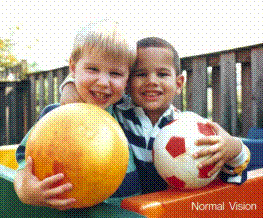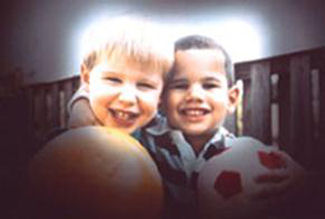Look, I Can Read; I Have Eyeballs Mostly Left
Types of Vision Problems
Nigh Mutual Developed Vision Issues
- Blurred vision (chosen refractive errors)
- Age-related macular degeneration
- Glaucoma
- Cataract
- Diabetic retinopathy
Near Common Childhood Vision Problems
- Blurred vision (called refractive errors)
- Crossed eyes (chosen strabismus)
- Lazy eye (chosen amblyopia)
Blurred vision (refractive errors)
- Nearsightedness (chosen myopia) is when you tin see clearly up close but blurry in the distance.
- Farsightedness (called hyperopia) is when you can see clearly in the altitude but blurry up close.
- If you are older than xl and have problem reading small print or focusing upwards shut, this is unremarkably due to a condition called presbyopia. Ane in every three people forty years or older in the U.South. will need spectacles to read smaller impress.
- Astigmatism is another condition that causes blurred vision, but it is because of the shape of the cornea.
These conditions bear upon the shape of the heart and, in turn, how the centre sees. They can be corrected by eyeglasses, contact lenses, and in some cases surgery.
What are the risk factors for developing refractive errors?
- Family history – parent(southward) who have one or more refractive errors
- Advancing age - presbyopia affects nearly adults over age 35
Crossed Eyes (strabismus)
Strabismus occurs when the eyes do not line upwardly or they are crossed. One eye, however, usually remains directly at whatever given time. Common forms of strabismus include:
- Esotropia – i or both eyes turn inward toward the nose
- Exotropia – one or both optics plough out; besides called wall-eyed
- Hypertropia – one or both eyes turn up
- Hypotropia – one or both eyes refuse
If detected early on in life, strabismus can be treated and fifty-fifty reversed.
If left untreated strabismus can cause amblyopia.
What are the risk factors for strabismus?
- Family unit history of strabismus
- Having a meaning corporeality of uncorrected farsightedness (hyperopia)
- Disabilities such every bit Down syndrome and cerebral palsy
- Stroke or head injury
Lazy Eye (amblyopia)
Amblyopia — often chosen lazy eye — is a problem that is common in children.
Amblyopia is a result of the encephalon and the optics not working together. The brain ignores visual information from i eye, which causes problems with vision evolution.
Treatment for amblyopia works well if the condition is establish early. If untreated, amblyopia causes permanent vision loss.
What are the take chances factors for amblyopia?
- Premature birth
- Low nascence weight
- Retinopathy of prematurity diagnosis
- Cerebral palsy diagnosis
- Intellectual disability diagnosis
- Family history of certain eye conditions
- Maternal smoking, drug or booze utilize
- Surgery on centre muscles for esotropia (eyes plough in toward nose)
Diabetic Retinopathy (DR)
All people with diabetes, both type ane and blazon 2, are at risk for DR. Information technology is caused by impairment to blood vessels in the back of the eye (retina). The longer someone has diabetes, the more likely he or she will become DR.
People with this status may not discover whatever changes to their vision until the damage to the optics is severe. This is why it is so important for people with diabetes to have a comprehensive centre exam every yr.
There are four stages of DR. During the commencement three stages of DR, treatment is usually not needed. To foreclose progression of diabetic retinopathy, people with diabetes should control their levels of blood sugar, claret pressure, and blood cholesterol. For the fourth phase of DR, called proliferative retinopathy, there are treatments that reduce vision loss, simply are non a cure for DR.
Warning signs of diabetic retinopathy includes blurred vision, gradual vision loss, floaters, shadows or missing areas of vision, and difficulty seeing at nighttime.
People with diabetes are at greater risk for cataract and glaucoma equally well.
What are the adventure factors for diabetic retinopathy?
- Type 1 or 2 diabetes
- Poor control of blood sugar level
- High blood pressure
- High cholesterol
- Pregnancy
- Being African American or Hispanic
- Smoking
| Normal vision | Vision with diabetic retinopathy |
|---|---|
 |  |
Photos courtesy of the National Eye Found, National Institutes of Health
Historic period-Related Macular Degeneration (AMD)
AMD is a disease that blurs the sharp, central vision needed to see straight-ahead. It affects the office of the eye called the macula that is found in the center of the retina. The macula lets a person see fine detail and is needed for things like reading and driving.
The more common dry out form of AMD can be treated in the early on stages to delay vision loss and possibly prevent the disease from progressing to the advanced stage. Taking certain vitamins and minerals may reduce the risk of developing avant-garde AMD.
The less mutual wet form of AMD may respond to treatment, if diagnosed and treated early on.
What are the adventure factors for AMD?
- Type 1 or 2 diabetes
- Poor control of claret sugar level
- Loftier blood pressure
- High cholesterol
- Pregnancy
- Being African American or Hispanic
- Smoking
| Normal vision | Vision with AMD |
|---|---|
 |  |
Photos courtesy of the National Eye Institute, National Institutes of Wellness
Glaucoma
There are unlike types of glaucoma, only all of them cause vision loss past dissentious the optic nerve. Glaucoma is chosen the "sneak thief of sight" because people don't unremarkably detect a trouble until some vision is lost.
The most common type of glaucoma happens because of slowly increasing fluid pressure level within the eyes.
Vision loss from glaucoma cannot be corrected. Simply if it is plant early, vision loss can be slowed or stopped. A comprehensive eye exam is important and so glaucoma can be constitute early.
What are the hazard factors for glaucoma? Anyone can take glaucoma, only some people are at college adventure of developing the disease.
- African Americans over age 40
- Everyone over age lx, especially Mexican Americans
- Those with a family history of glaucoma
| Normal vision | Vision with glaucoma |
|---|---|
 |  |
Photos courtesy of the National Eye Institute, National Institutes of Wellness
Cataract
A cataract is a clouding of the lens of the eye. It often leads to poor vision at dark, peculiarly while driving, due to glare from bright lights.
Cataracts are nearly mutual in older people, but can also occur in young adults and children.
Cataract treatment is very successful and widely available.
What are the hazard factors for cataracts?
- Age, cataracts are more common later age lx
- Certain diseases such as diabetes
- Smoking and alcohol use
- Also much exposure to sunlight
| Normal vision | Vision with cataract |
|---|---|
 |  |
Photos courtesy of the National Eye Found, National Institutes of Wellness
Source: https://www.health.ny.gov/diseases/conditions/vision_and_eye_health/types_of_vision_problems.htm
0 Response to "Look, I Can Read; I Have Eyeballs Mostly Left"
Postar um comentário